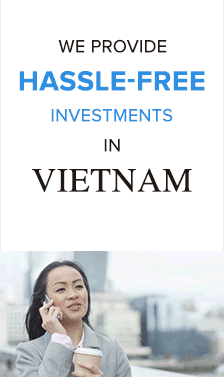High Investment Potential District of Vietnam – HCMC Property Seminar
A strong economy trajectory paired with the government’s ambitious policies and expansion plans has prepared Ho Chi Minh City, Vietnam to be the center of attention to investors worldwide. The city’s property market has excelled and high quality projects are highly favored among investors in Hong Kong. Golden Emperor Properties hosted a ‘High Investment Potential District of Vietnam’ seminar over the weekend and launched Malaysian-listed developer, Gamuda Land’s latest project, Celadon City’s Diamond Alnata. The prestigious residence is situated in HCMC’s ‘Taikoo Shing’- a city-within-a-city concept – in the center of HCMC’s largest AEON shopping center and the city’s emerging business hub. The launch attracted a number of investors to our two-day seminar and exhibition event.
Photo Above: Asia Bankers Club CEO and Founder, Mr. Kingston Lai discusses the property market trend of Ho Chi Minh City.
UNIQLO to open first store in Vietnam next year
Japanese casual clothing retailer UNIQLO unveiled its plans to open its first store in Vietnam during the fall of 2019, marking its further expansion in Southeast Asia.
“The Southeast Asia region has been an important growth driver for us, and we are pleased and optimistic about our opportunity to be part of such an exciting economy and retail market,” said Tadashi Yanai, Chairman, President and CEO of Fast Retailing Co., Ltd., the parent company of UNIQLO.
“We look forward to introducing Uniqlo and our high-quality, affordable LifeWear apparel in Vietnam, as well as making a positive contribution to the economy and communities where we operate,” Yanai added.
The first UNIQLO store will be opened in Ho Chi Minh City and operate under a joint venture between Mitsubishi Corporation and Fast Retailing, who will own 25 percent and 75 percent of the company, respectively.
More stores will be available in the city before they expand to other parts of Vietnam.come
UNIQLO will also soon begin recruiting key employees for its operation in Vietnam through the launch of its UNIQLO Manager Candidate programme.
The Japanese retailer plans to double its number of stores in Southeast Asia and Oceania to about 400 by 2022. The brand’s global network currently covers 20 markets in Asia, Europe, North America, and Australia, with a total of about 2,000 stores.
The firm also aims to triple its revenue in Southeast Asia to 300 billion JPY (2.71 billion USD) in the year ending in August 2022.
Last fiscal year, ending in August 2017, its parent company, Fast Retailing Co., Ltd., earned 16.87 billion USD in revenue.
The upcoming appearance of UNIQLO in Vietnam will place it in competition with some of the well-known foreign brands like Zara and H&M already present in the country. Currently, Vietnamese people can only purchase Uniqlo products from individual sellers or order them from other countries.
Source: Vietnam+
Feasibility report ready for Vietnam’s $58 billion high-speed railroad
Vietnam’s north-south high-speed railway is expected to cost $58 billion, according to a feasibility report released at a meeting Tuesday.
The 1,545-kilometer route from Hanoi to Ho Chi Minh City will have double standard-gauge tracks of 1.435-m width and 23 stations, according to a consultancy consortium comprising Vietnamese firms TEDI, TRICC and TEDIS.
It will adopt the distributed traction technology used by Japanese high-speed trains.
Sixty percent of the tracks will be on viaducts, 10 percent underground and 30 percent on the surface, completely protected by fencing and without a single crossing.
Two sections – from Hanoi to the central city of Vinh and from the central city of Nha Trang to HCMC – will be built first in 2020-2030 at a cost of $24 billion, and commercial operations are likely to begin in 2032.
All sections are expected to be completed and operational by 2040-2045. Transport time from Hanoi to HCMC will be eight hours, while the current train takes 24 hours.
The speed of the trains on the route would determine the attractiveness of the project, the report said, explaining that if it runs at 200 kilometers an hour, it would only account for 2.7 percent of the transportation share on the Hanoi – Nha Trang section.
But if it increases to 350 kilometers, the share could reach 14 percent and the railroad could compete with airlines, it said.
The proposal is for trains to run at 160-200 km speed after the first section is complete, and 350 km when the entire project is finished.
At the meeting, Deputy Minister of Transport Nguyen Ngoc Dong said this feasibility report would be considered by authorities before being scrutinized by a European consultancy. “The transport ministry will invite bids to select that consultancy.”
The north-south high-speed railroad was recently revived after being rejected by the National Assembly in 2010 due to its $56-billion price tag, which was half of Vietnam’s GDP then.
If approved by the government now, it will be submitted to the house again next year.
Experts said it might be more favorably viewed by the NA as well as the public due to Vietnam’s better financial position and greater demand for advanced infrastructure.
The existing 3,000-kilometer railroad network has not received any major investment since it was built 140 years ago, and does not have the capacity for high speeds.
Investment in railways currently accounts for only one percent of the transportation sector’s total budget.
The NA approved a plan earlier this month to upgrade it at a cost of $300 million.
Source VnExpress
Vietnam, Ho Chi Minh City to Create 78 Thousand More Job Opportunities in Q3 2018
Vietnam’s largest city, Ho Chi Minh City has attracted much attention globally in the last years with its soaring economic growth. Vietnam’s Bureau of Statistics reported that its GDP increased by 7.08% in the first half of 2018, the highest growth rate in the previous 7 years. Manufacturing and after- production and wholesale and retail sectors achieved the highest growth at 13% and 8.2% respectively. Commercial construction grew by 9% from the previous year, setting a new record-high.
Vietnam’s economy is further powered by its tourism sector, which attracted over 7.89 million visitors to Vietnam in the first half of 2018. It is estimated that the total amount of visitors will accumulate to 15.5 million in 2018 and create a revenue of over USD 2.71 billion nationwide. As economy soars, foreign investments and infrastructure initiatives will suffix a large job creation in 2018.
Reports from Ho Chi Minh City Institute for Development Studies, reveal that as Vietnam’s labor market grows, new businesses will emerge onto the market, including positions for web security, GPS applications, gaming applications, 3D game design and 3D digital design.
In the first half of 2018, companies in HCMC have focused on hiring an experienced work force and hosted job fairs and seminars to attract those with strong professional backgrounds. Vietnam’s Ministry of Labor and Market surveyed over 17,271 corporations and revealed that there are at least over 64,500 positions available and over 68,800 workers to be hired in 2018.
In the first half of 2018, the demand for a workers increased by 24.4% year on year in industries including retail, service, textile, footwear, finance, banking, accounting and auditing.
The report also revealed that in the second half of 2018, Ho Chi Minh City will need to hire over 148 thousand workers. By Q3 of 2018, companies will need to hire over 78 thousand workers in marketing, retail, robotics, construction, information technology, textile and footwear manufacturing, corporate management and accounting, in which all will require professionally trained workers.
Ho Chi Minh City Institute for Development Studies Center Co-Manager, Tran Anh Tuan, states that the city will continue to attract a large and well-trained work force and experienced professionals to support the city’s growing sectors. At the same time, Ho Chi Minh City will continue to develop facilities to train its young population to ensure that business sectors will continue to grow and flourish.
Moody’s: Vietnam’s strong growth potential will support a stabilization in the debt burden
Moody’s Investors Service says that strong economic growth will likely continue in Vietnam (Ba3 stable) over the next few years and support a stabilization in debt.
The growth will be supported by the economy’s rising competitiveness, healthy trade flows and robust consumption, but banking system risks and a history of susceptibility to destabilizing financial market cycles remain a constraint on broader economic strength.
Moody’s conclusions are contained its just-released report, “Government of Vietnam: FAQ on prospects for growth, trade and government debt”.
Moody’s report says that investment is largely responsible for the 6% growth recorded over the last decade for the Vietnamese economy, but productivity will increasingly drive headline growth as the economy moves up the value-chain and the role of the private sector increases.
These competitiveness improvements, together with a mix of healthy trade flows and robust consumption will support average GDP growth of 6.4% between 2018-2022, which is nearly double the 3.5% median for Ba3-rated sovereigns.
Meanwhile, the effects of the ongoing trade dispute between the USA (Aaa stable) and China (A1 stable) may be detrimental for Vietnam if tariffs are extended to products within the mobile phone supply chain – that Vietnam specializes in – or affected other economies with which it has strong trade ties, such as Korea (Aa2 stable).
Potentially partly offsetting this scenario is the consideration that Vietnam would stand to gain from a diversion in market share of products at the lower-end of the value chain, such as textiles and garments.
Previous periods of rapid credit growth have weakened bank solvency and raised contingency risks for the sovereign. While credit allocation has somewhat improved and now poses lower risks to the sovereign, credit growth remains beyond the pace warranted by financial deepening trends, raising the risk of a correction that would amplify the negative impact of an economic shock.
While Moody’s still sees the banking system as the primary source of event risk, the acute systemic risks that contributed to the downgrade in 2012 have abated. The average baseline credit assessment for the 16 Vietnamese banks we rate has improved to b2 from b3 due mainly to improvements in asset quality, stabilizing capitalization, and a recovery in profitability.
At 52% of GDP, government debt is now largely in line with the median of about 50% for Ba-rated sovereigns. The rapid pace of nominal economic growth will stabilize debt at this level. Moreover, the structure of debt has improved, with lengthening maturities and a declining share of foreign-currency debt limiting Vietnam’s vulnerability to financial shocks.
Source: Moody’s
























